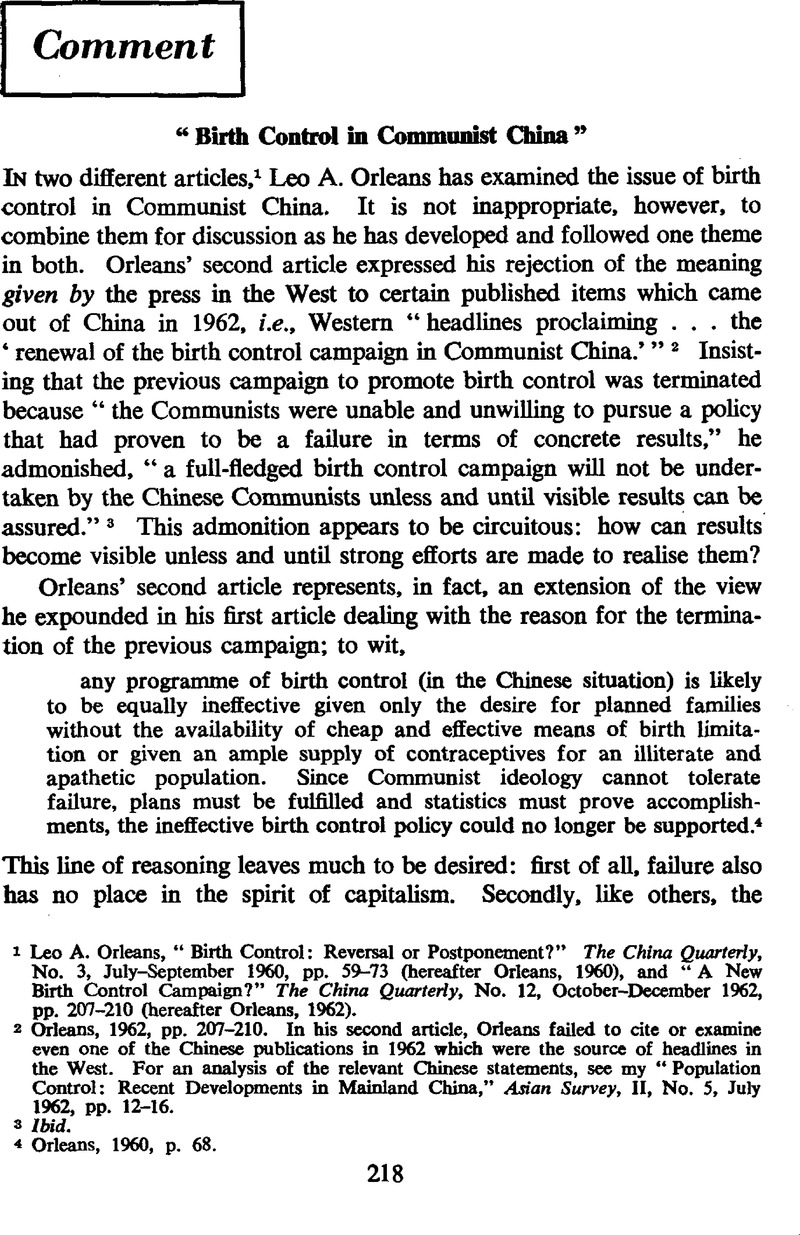No CrossRef data available.
Article contents
Comment
Published online by Cambridge University Press: 17 February 2009
Abstract

- Type
- Comment
- Information
- Copyright
- Copyright © The China Quarterly 1963
References
1 Orleans, Leo A., “Birth Control: Reversal or Postponement?” The China Quarterly, No. 3, 07–09 1960, pp. 59–73CrossRefGoogle Scholar (hereafter Orleans, 1960), and “A New Birth Control Campaign?” The China Quarterly, No. 12, 10–12 1962, pp. 207–210 (hereafter Orleans, 1962).Google Scholar
2 Orleans, 1962, pp. 207–210. In his second article, Orleans failed to cite or examine even one of the Chinese publications in 1962 which were the source of headlines in the West. For an analysis of the relevant Chinese statements, see my “Population Control: Recent Developments in Mainland China,” Asian Survey, II, No. 5, 07 1962, pp. 12–16.Google Scholar
3 Ibid.
4 Orleans, 1960, p. 68.
5 Ibid. pp. 63–64, 68–69 and 70–73.
6 Yin-ch'u, Ma, “New Population Theory,” in The Complete Report, First National People's Congress, Fourth Session (Peking: 1957), pp. 297–317.Google Scholar A revised version of this speech later appeared in Hsin Chien-she (New Construction), No. 11, 11 7, 1959, pp. 52–53.Google Scholar A translation of this shortened paper is given at the end of Orleans, 1960.
7 Kuang-ming Daily, 04 4, 1957.Google Scholar It has been erroneously reported that Ma first publicised his “Population Theory” at the National People's Congress, on July 3, 1957.
8 Orleans, 1960, p. 61.
9 Ibid. p. 63. Italics added.
10 Ibid.
11 Ibid. However, this article “Do Not Allow the Rightists to Use the Population Question to Advance their Political Conspiracy,” by Li P'u, appeared in the October 4, instead of October 14. issue of People's Daily.
12 Hsiao-t'ung, Fei, in The Complete Report, First National People's Congress, Fourth Session (Peking: 1957), pp. 1334–1340.Google Scholar
13 Li-tzu, Shao, in The Complete Report, op. cit., pp. 880–881.Google Scholar
14 Li P'u, op. cit.
15 Orleans, 1960, p. 60.
16 Teh-ch'uan, Li, in The Complete Report, First National People's Congress, Third Session, 1956, pp. 143–150.Google Scholar
17 Teh-ch'uan, Li, speech before the Second National Committee of the People's Political Consultative Conference, Third Session, People's Daily, 03 8, 1957.Google Scholar
18 Teh-ch'uan, Li, in The Complete Report, First National People's Congress, Fourth Session (Peking: 1957), pp. 749–755.Google Scholar
19 Orleans, 1960, p. 68. Italics added.
20 People's Daily, 03 5, 1957.Google Scholar
21 Orleans, 1960, p. 60.
22 See People's Handbook for 1953.Google Scholar
23 See “Communist China—The Population Problem,” in Current Notes on International Affairs, Department of External Affairs, Canberra, Australia, XXIX, No. 2, pp. 713–726, 11 1958.Google Scholar
24 Micklewright, F. H. Amphlett, “The Rise and Decline of English Neo-Malthusianism,” Population Studies, XV, No. 1, pp. 32–51, 07 1961.CrossRefGoogle Scholar
25 See Davis, Kinsley, “Malthus and the Theory of Population,” in Lazarsfeld, Paul F. and Rosenberg, Morris, editors, The Language of Social Research (Glencoe, Ill.: The Free Press, 1955), pp. 540–553.Google Scholar
26 Hui-nan, Chung, People's Daily, 03 17, 1957.Google Scholar Chung was later accused of resisting the leadership of the Party, and of being a “bourgeois” expert, see Journal of Chinese Medicine, No. 10, 10 1958.Google Scholar
27 Hsiao-t'ung, Fei, “What is Meant by Demographic Research?” New Construction No. 4, 04 1957, pp. 5–6Google Scholar; Ching-chao, Wu, “A New Treatise on the Problem of China's Population,” New Construction, No. 3, 03 1957, pp. 1–16Google Scholar; and Ta, Ch'en, “Deferred Marriage, Birth Control, and Population Problems of New China,” New Construction, No. 5, 05 1957, pp. 1–16.Google Scholar
28 Cheng-nan, Ch'en, Wen Hui Pao (Shanghai), 05 3 and 4, 1957.Google Scholar Wang's personal indignation must have been considerable, for he had been even suspicious of the motives of Shao Li-tzu whose views proved acceptable. See Ya-nan, Wang, Marxist Population Theory and China's Population Problems (Peking: Science Publishing Co., 1956), p. 2.Google Scholar
29 For a fuller account of this incident, see my letter to the editor, American Sociological Review, XXVII, No. 3, pp. 413–414, 06 1962.Google Scholar It should be added that not all sociologists and demographers trained in the west were in agreement with the position of Fei, Wu and Chen. For instance, Sun Pen-wen, who was trained in the United States, published an article at the zenith of the hundred flowers, espousing the thesis that “800,000,000 is the most suitable population for our country” (Wen Hui Pao, 05 11, 1957Google Scholar). In fact, when Fei, Wu, Chen and others were being criticised after the spring of 1957, Sun Pen-wen joined in the attack at a symposium (August 29, 1957) organised by the Academic Department of Philosophy and Social Sciences of the Academy of Sciences. Sun “drawing from his own experience, discussed the reactionary nature of ‘bourgeois’ sociology and the so-called sociological investigation. He pointed out that, from the standpoint of either theory or the investigation of substantive problems, bourgeois sociology only serves to benefit the bourgeois class and the capitalistic system” (New China Fortnightly (Hsin-hua Pan-yueh-k'an), No. 118, 10 25, 1957, p. 86).Google Scholar
30 They and Chang Nai-ch'i were consequently removed from their ministerial posts in the Ministries of Communications, Timber Industry and Food respectively.
31 Fei, , The Complete Report, Peking, 1957, op. cit.Google Scholar
32 Chen-lin, T'an, “Strive for the Fulfilment, Ahead of Schedule, of the National Programme for Agricultural Development,” in National Programme for Agricultural Development, 1956–1967 (Peking: Foreign Languages Press, 1960), pp. 31–32.Google Scholar
33 Pai-kun, Chang et al. , “A Socialist Theory of Population and China's Population Problem,” Economic Research (Ching-chi Yen-chiu), No. 4, 08 17, 1957, pp. 36–63.Google Scholar
1 Alsop, Joseph, “On China's Descending Spiral”Google Scholar and Schran, Peter, “Some Reflections on Chinese Communist Economic Policy,” The China Quarterly, No. 11, 07– 09 1962.CrossRefGoogle Scholar
1 Shen, T. H., Agricultural Resources of China (Ithaca: Cornell University Press, 1951).Google ScholarPubMed
2 Ten Great Years (Peking: Foreign Languages Press, 1960).Google Scholar




